With approximately 10,000 distinct species soaring across our planet, the avian world is a realm of incredible diversity. When we consider the sheer scale of these creatures, the question naturally arises: what’s the largest flying bird? Defining “largest” can be tricky – do we measure by length, weight, or perhaps the volume of water displaced, like an avian Archimedes? However, for creatures designed to conquer the skies, wingspan seems the most fitting metric. After all, it’s the breadth of their wings that truly dictates their aerial dominance, casting impressive shadows as they glide overhead.
This exploration focuses on identifying the largest flying birds by wingspan, while also acknowledging some of the heavyweight champions of the avian world. We’ll delve into the wingspans, weights, and unique characteristics of these magnificent birds. It’s worth noting that some weight figures are estimates from various reports, while others are firmly established. To maintain clarity and avoid repetition, we’ve curated a list that highlights diverse species, rather than creating a lengthy roll call of similar vultures, pelicans, and albatrosses.
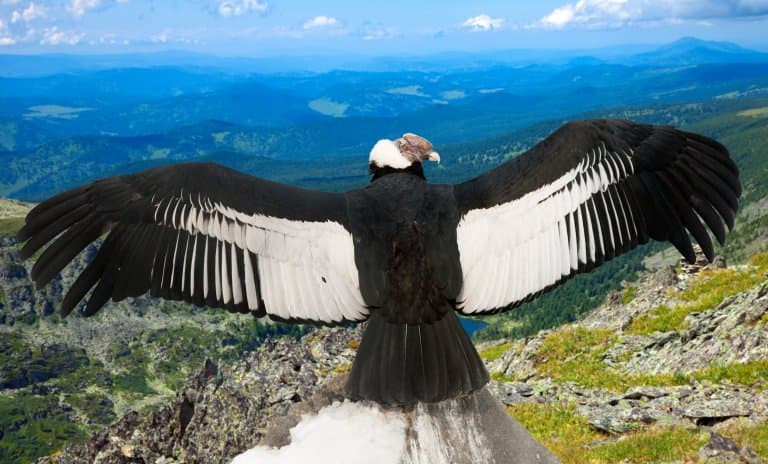 Andean Condor Wingspan: A Giant of the Skies
Andean Condor Wingspan: A Giant of the Skies
Here’s our curated top ten list of the largest animals to grace the skies, considering wingspan, weight, and a touch of diversity to keep things captivating.
10. Blakiston’s Fish Owl (Wingspan: 1.8 m / 6 ft)
Weight: 4.6 kg / 10 lb
Hailing from the remote regions of East Asia and Russia, the Blakiston’s Fish Owl is an exceptionally rare and imposing eagle owl. It often finds itself in a wingspan showdown with its close relative, the Eurasian eagle owl, both vying for the title of widest wingspan among owls. Both species can achieve wingspans around 1.8 meters (6 feet) and slightly beyond.
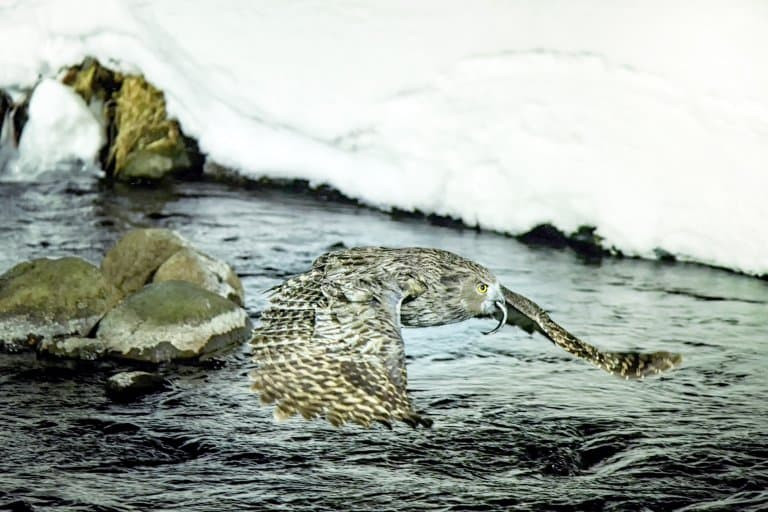 Blakiston’s Eagle Owl: A Rare Giant
Blakiston’s Eagle Owl: A Rare Giant
While the Eurasian eagle owl might occasionally claim a slightly larger maximum wingspan, the Blakiston’s Fish Owl arguably boasts a greater average wingspan. Given their significantly smaller population size and precarious conservation status, the Blakiston’s Fish Owl rightfully earns its place among the giants. These owls are not only large in wingspan but also in stature, preying on fish and other aquatic creatures in the dense forests of their habitat.
9. Dalmatian Pelican (Wingspan: 1.9 m / 6.2 ft)
Weight: 15 kg / 33 lb
The Dalmatian Pelican isn’t just the largest pelican species; it’s also one of the most substantial birds capable of flight. Sporting a massive pouch and an impressive wingspan nearing two meters, this pelican dwarfs its canine namesake in size.
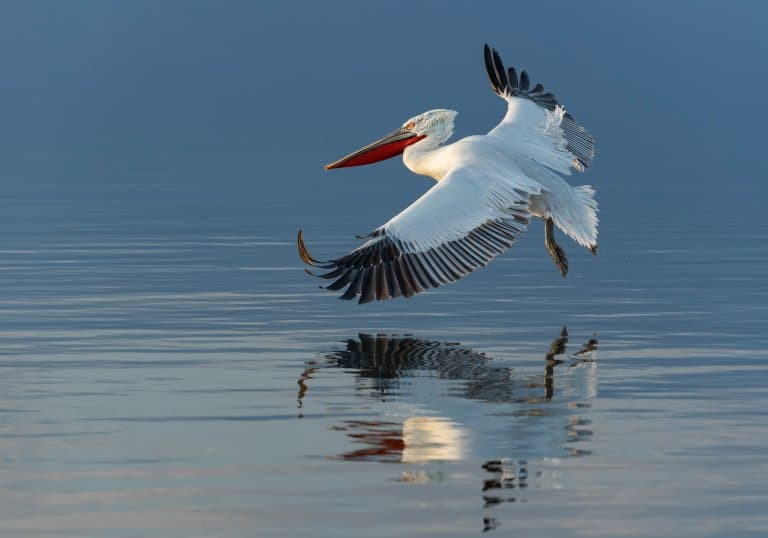 Dalmatian Pelican: Sizeable Swimmer and Flyer
Dalmatian Pelican: Sizeable Swimmer and Flyer
These birds are far from delicate; they can reach a considerable weight of 15 kg (33 lb), making them one of the heaviest flying bird species. There are anecdotal claims of even larger wingspans, some suggesting they rival or even exceed the wingspan of the bird at the very top of this list. However, these claims lack robust scientific backing. Despite the unverified reports, average wingspan measurements reach up to 1.9 meters, with some older citations suggesting up to 2.8 meters, solidifying its position as a truly massive bird in flight. While the Great White Pelican is a close contender, the Dalmatian Pelican generally edges it out as the larger species on average.
8. Secretarybird (Wingspan: 2.1 m / 6.9 ft)
Weight: 4.27 kg / 9.4 lb
The Secretarybird possesses an almost prehistoric aura, looking like a creature straight out of a dinosaur exhibit. It’s as close to a living dinosaur as you can realistically find! Not only is it a relatively heavy bird, but it also stands tall, reaching up to 1.3 meters in height.
 Secretarybird in Flight: Terrestrial Hunter with Impressive Wings
Secretarybird in Flight: Terrestrial Hunter with Impressive Wings
This combination of size, weight, and a body structure that isn’t ideally aerodynamic means the Secretarybird relies heavily on wind currents for lift. Flapping flight is typically brief, as these birds predominantly spend their time striding across the African savanna, hunting snakes and other prey in the tall grasslands. Their long legs are perfectly adapted for their terrestrial lifestyle, but when airborne, their impressive wingspan is undeniable.
7. Steller’s Sea Eagle (Wingspan: 2.3 m+ / 7.5 ft)
Weight: 10 kg / 22 lb
As we enter the realm of eagles, we encounter a wealth of conflicting information and national pride. Eagles hold a special place in human culture, often symbolizing power and majesty, and have been adopted as emblems by numerous nations throughout history.
 Steller’s Sea Eagle: A Majestic Raptor
Steller’s Sea Eagle: A Majestic Raptor
Adding to the mystique, eagles are undeniably captivating creatures, leading to a natural desire to identify the largest of them all. This quest for the biggest eagle has fueled a sort of unofficial competition, with various contenders vying for the title. Notable entrants include the Steller’s Sea Eagle (representing Russia), the Harpy Eagle (from Central and South America), the Philippine Eagle, and the Bald and Golden Eagles (representing the United States). Each of these magnificent birds has been claimed to possess wingspans exceeding 2.4 meters (8 feet), but verifiable measurements are often elusive. We’ve given the nod to the Steller’s Sea Eagle, as it is consistently recognized as the heaviest eagle in the world, granting it some extra weight in this avian contest.
6. Trumpeter Swan (Wingspan: 2.4 m / 7.9 ft)
Weight: 15 kg / 33 lb
Now we’re truly entering heavyweight territory. The Trumpeter Swan, the largest waterfowl on Earth, outweighs many other birds on this list despite its elegance in the water and air.
 Trumpeter Swan: North America's Largest Waterfowl
Trumpeter Swan: North America's Largest Waterfowl
These swans are widespread across North America, larger and more vocal than their European swan cousins. While European populations faced near extinction due to hunting for meat and feathers, North American Trumpeter Swans have fared better. Their sheer size provides a natural defense; apart from human hunters, few predators dare to challenge them, allowing them to live relatively peacefully. Young swans grow rapidly on a diet rich in protein-packed insects, while adults primarily consume vegetation, contributing to their impressive size and lifespan, which can exceed 30 years.
5. Kori Bustard (Wingspan: 2.47 m / 8.1 ft)
Weight: 18 kg / 39 lb
The Kori Bustard is a truly substantial bird, often cited as the heaviest flying animal in the world. It also earns its place among the largest wingspans, making it a double threat in avian size rankings.
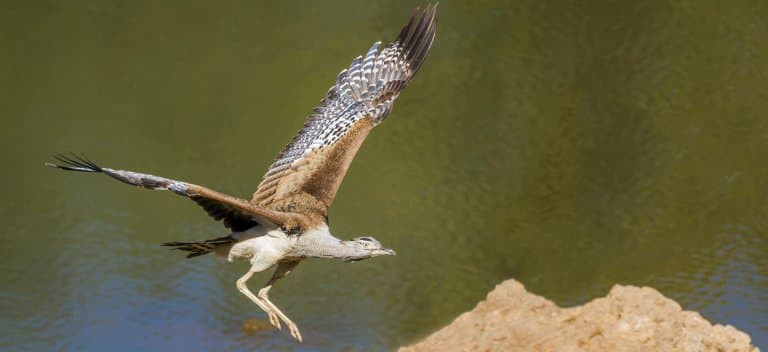 Kori Bustard: Heaviest Flying Bird Contender
Kori Bustard: Heaviest Flying Bird Contender
Similar to the Secretarybird, the Kori Bustard is capable of flight but prefers to spend most of its time on the ground foraging for food and even engaging in territorial disputes with Secretarybirds. While some accounts claim weights reaching 20 kg, a more reliably reported weight is around 18 kg. Standing over a meter tall, its bulk provides a significant advantage in confrontations with more agile rivals.
4. Marabou Stork (Wingspan: 2.9 m / 9.5 ft)
Weight: 9 kg / 20 lb
The Marabou Stork, almost as tall as the Secretarybird but a far more proficient flier, is a striking and somewhat ungainly bird. These enormous storks are common scavengers, often found around trash heaps in East Africa, casting imposing shadows as they approach.
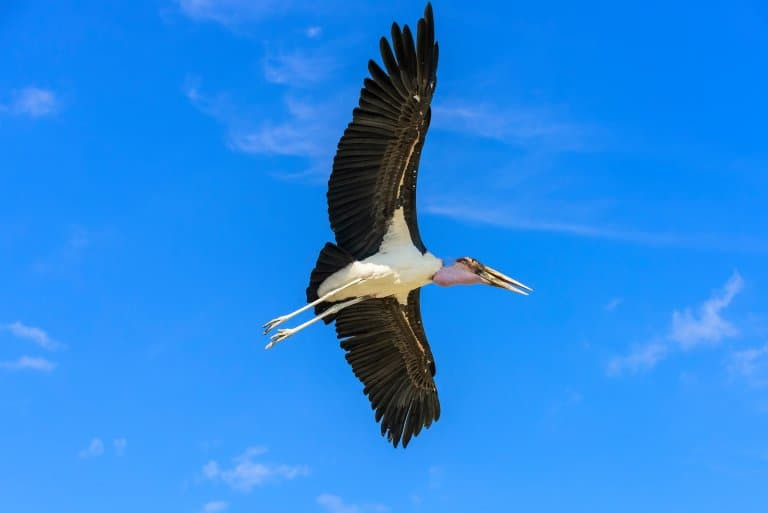 Marabou Stork Wingspan: An African Scavenger Giant
Marabou Stork Wingspan: An African Scavenger Giant
Claims exist of Marabou Storks reaching wingspans exceeding 3 meters, with some suggesting they rival the Andean Condor for the largest wingspan among flying birds. However, these reports currently lack solid verification. Nevertheless, the Marabou Stork is undeniably one of the largest flying birds. While perhaps lacking the aesthetic appeal of the condor with its bald head and peculiar, testicle-like neck appendage, it possesses a unique, almost “ugly cute” charm. Reaching heights of 1.2 meters and wingspans of 2.9 meters, Marabou Storks ( Leptoptilos crumeniferus) stand as one of the largest bird species on our planet.
3. Andean Condor (Wingspan: 3 m / 9.8 ft)
Weight: 16 kg / 35 lb
The Andean Condor’s average weight and wingspan surpass nearly every other flying bird, making it arguably the largest flying creature in existence, at least on average.
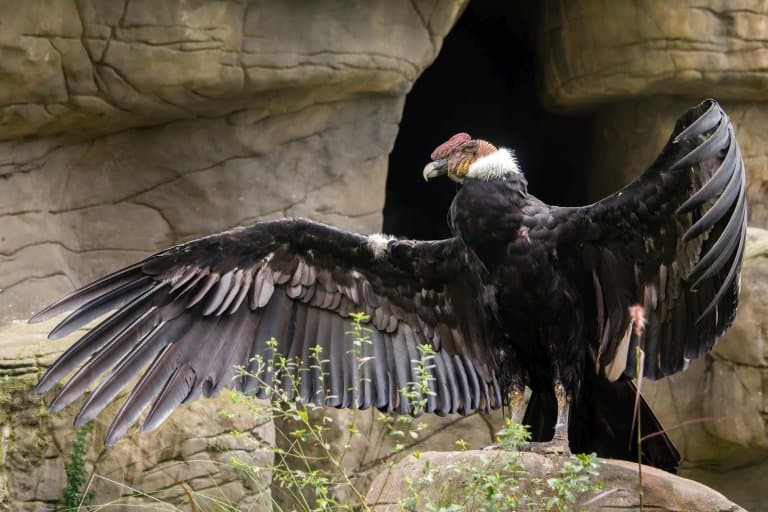 Andean Condor: King of the Andes
Andean Condor: King of the Andes
While male Kori Bustards can occasionally outweigh them, and exceptionally large individuals of the following species may exceed the condor’s wingspan, the Andean Condor remains the largest flying bird in overall average measurements. Their immense wing area allows them to stay aloft for hours, often without a single flap of their wings. This remarkable energy efficiency is crucial for a bird of this size, enabling them to soar effortlessly across the Andean skies. The Andean Condor holds the title of the largest flying bird in the Western Hemisphere and globally when considering the combination of weight and wingspan.
2. Cinereous Vulture (Wingspan: 3 m / 9.8 ft)
Weight: 13 kg / 28.6 lb
The Cinereous Vulture is another raptor facing stiff competition for the title of largest wingspan. The Himalayan Vulture boasts a very similar wingspan, making it challenging to definitively rank them. However, the Cinereous Vulture, with its arguably more evocative name and slightly heavier build, secures its place here.
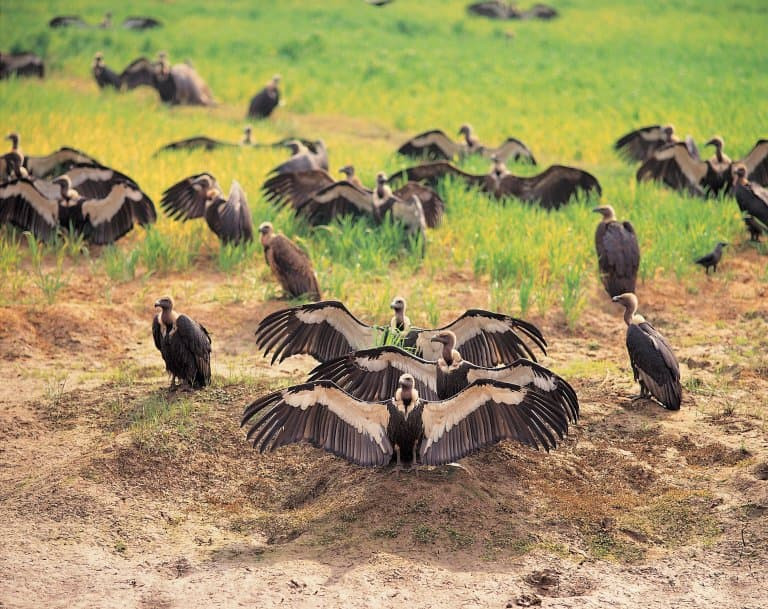 Cinereous Vultures: Old World Giants
Cinereous Vultures: Old World Giants
The Cinereous Vulture is the largest Old World vulture and a formidable member of the bird of prey family. This species’ range extends from Spain across Europe, the Middle East, and Asia. They are also remarkably long-lived, with some individuals reaching nearly 40 years of age. Though they have faced threats from poisoning and extinction in much of Western Europe, reintroduction programs have shown promise in restoring their populations. Primarily scavengers, Cinereous Vultures have been known to occasionally prey on young livestock, a testament to their imposing size and strength.
1. Wandering Albatross (Wingspan: 3.2 m / 10.5 ft)
Weight: 12 kg / 26.4 lb
Of all the birds on this list, the Wandering Albatross likely faces the least competition for the top spot in wingspan. While other albatross species come close, the Wandering Albatross consistently measures a wingspan of 3.2 meters (10.5 feet), with credible reports of individuals reaching an astonishing 3.5 meters.
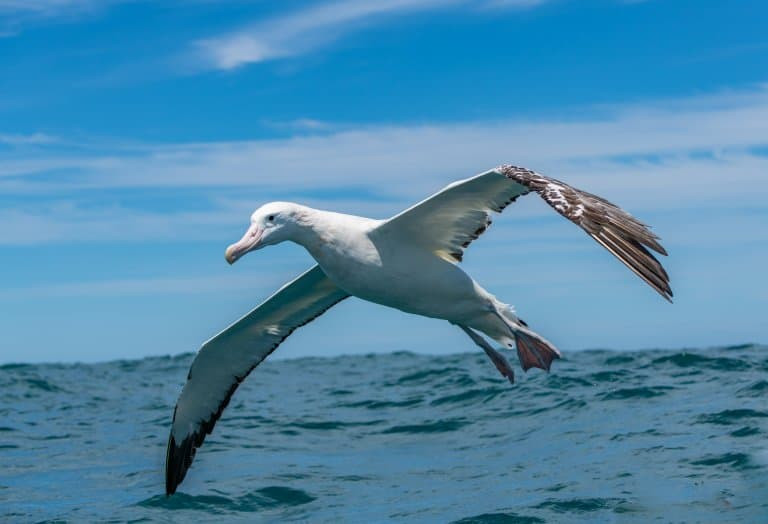 Wandering Albatross: Master of the Long Flight
Wandering Albatross: Master of the Long Flight
The Guinness Book of World Records even recognizes a Wandering Albatross with a wingspan of 3.63 meters (11 ft 11 in) as the largest wingspan ever recorded for a living bird species. This incredible specimen was measured in 1965 by scientists aboard the USNS Eltanin research vessel in the Tasman Sea. These are true long-distance champions, capable of traveling over 120,000 km (75,000 miles) in a single year and covering 900 km (560 miles) or more in a single day. Their unparalleled wingspan allows them to spend almost their entire lives airborne, only landing to feed and breed. They are truly masters of the sky, perfectly adapted for a life spent traversing vast ocean expanses.
Final Thoughts
This concludes our exploration of the largest flying birds in the world by wingspan that grace our skies today. But does size truly matter? For some, the sheer size of these birds is a source of fascination and wonder. For researchers, however, size is a crucial, measurable metric that provides insights into species conservation and the health of their environments.
From size measurements, scientists can deduce vital information about an animal’s physical and ecological characteristics, including sex, dietary needs, energy requirements, and their role in nutrient cycling within ecosystems. In most bird species, males are typically larger than females. However, in some avian families, including birds of prey, raptors, eagles, and shorebirds, this size dimorphism is reversed, with females being larger. The reasons behind this phenomenon remain an intriguing area of ongoing research.
It’s important to remember that this list focuses specifically on flying birds, excluding flightless giants like the ostrich or southern cassowary. Flightless bird species constitute only a small percentage (around 1%) of all bird species. They generally possess smaller wings but compensate with denser bones and significantly heavier bodies. In fact, the top 10 heaviest birds in the world are all flightless species, as they are no longer constrained by the demands of flight, allowing them to evolve to much larger sizes.